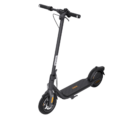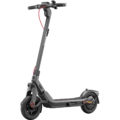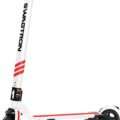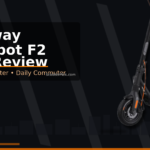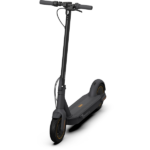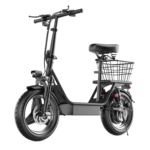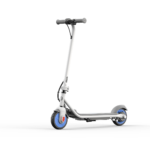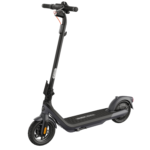- Home
- Scooters
- Electric Scooters
- Segway Ninebot C2 Lite
Segway Ninebot C2 Lite



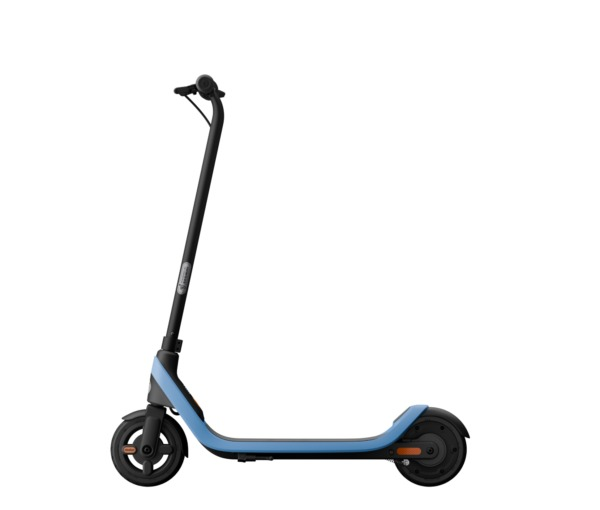
- Battery Range: 14 km (8.7 mi)
- Top Speed: 16 km/h (10 mph)
- Motor Power: 120 W nominal
- Weight Capacity: 50 kg (110 lb)
- Charging Time: 5.5 h
- Scooter Weight & Portability: 7.8 kg (17.2 lb)
PROS
- Light 7.8 kg frame
- Up to 16 km/h with 3 modes
- Solid tyres = no flats
- RGB under-deck lights
- Simple controls for beginners
CONS
- No folding mechanism
- Short range at max speed (~9 km)
- No app connectivity
- Rear brake only
- No suspension


Overview: Lightweight Fun for Younger Riders
The Segway Ninebot C2 Lite brings the proven C-series formula to younger riders with a lighter frame, friendlier handling, and simple controls. It reaches up to 16 km/h, offers up to 14 km of theoretical range (with about 9 km at maximum speed), and weighs just 7.8 kg. Consequently, parents can lift it without strain, and kids can maneuver it comfortably at neighborhood speeds. Because it rolls on solid 7-inch tyres, flats stay off the agenda. Meanwhile, bright RGB under-deck lights add both visibility and unmistakable “this is fun!” vibes.
A 120 W nominal brushless motor delivers smooth, predictable thrust that builds confidence instead of surprising new riders. Three ride modes let parents and kids match speed to skill, so learning feels structured rather than risky. Charging from near empty takes roughly 5.5 hours, which fits easily into a school night or a weekend afternoon. With an IPX4 rating and a compact footprint, the C2 Lite suits short neighborhood rides, courtyard practice, and school-yard loops. Because there is no folding mechanism, storage is “as-is”—yet the light weight makes carrying straightforward. For best battery health, store the scooter indoors and keep the pack around half charge if pausing riding for weeks.
Altogether, the C2 Lite balances safety, simplicity, and fun. It gives younger or smaller riders a supportive platform to learn the basics—steering, speed control, and smooth stopping—while keeping maintenance light for families who want more play and less tinkering.
Who the C2 Lite Is For (and Why It Fits)
The C2 Lite is designed for families who value lightweight handling, gentle power, and low-maintenance ownership. It is a great fit for:
- Younger riders who are just graduating from push scooters and need measured speed that invites practice rather than fear.
- Parents who want predictable behavior, clear lighting, and easy carry weight for stairs, car boots, and hallway storage.
- Neighborhood routes that favor short, supervised rides on sidewalks, park paths, cul-de-sacs, and school courts.
- Limited storage situations where a compact, light scooter is easier to stash even without a folding hinge.
Because the C2 Lite emphasizes approachability, it encourages daily use. Kids hop on more often. Parents relax more quickly. And families discover that short scooter sessions turn into dependable routines.
Design Philosophy: Light, Clear, and Confidence-Building
Everything about the C2 Lite’s design helps small riders feel in control. The deck height stays friendly, so stepping on and off feels natural. The handlebar reach suits shorter arms, which improves steering precision and reduces over-correction. The cockpit remains clean and uncluttered; kids see what matters—speed indicator, battery bars, and mode—without a busy cluster of toggles.
Style matters as well, and the RGB under-deck lighting delivers. It makes the scooter easy to spot from the side at dusk, which adds a practical safety layer. At the same time, it gives kids a sense of ownership and excitement. They love the glow. You love the visibility. Everyone wins.
Because the chassis weighs only 7.8 kg, it feels less intimidating. Riders move it around the driveway without help. Parents lift it into the car with one hand. And hallways stay uncluttered since the scooter is easy to reposition.
Motor and Throttle: Smooth Power That Teaches Good Habits
The C2 Lite uses a 120 W brushless motor tuned for predictable launches and steady cruising. Instead of lurching forward, the scooter builds speed smoothly. As a result, kids keep elbows soft, heads up, and eyes scanning where they want to go. Gentle power teaches relaxed posture—the foundation for balance and control.
Throttle action is progressive, which helps kids learn the relationship between small thumb movements and speed changes. Because the top speed caps at up to 16 km/h, children can explore pace without outrunning their skills. In short, the motor behaves like a coach: encouraging, controlled, and consistent.
Three Ride Modes: Step-by-Step Skill Building
Progress sticks when it’s structured. The C2 Lite’s three ride modes create a clear ladder:
- Power-assist: The scooter provides a light push once the rider is rolling. Kids practice stance, balance, and steering with minimal extra speed.
- Standard: Moderate acceleration and a comfortable cruise for open paths. This mode is the daily default for most families.
- Sport: The most responsive mapping within the 16 km/h cap. Parents can introduce it after consistent control, smooth braking, and responsible path etiquette.
Because mode changes are simple, adults can set limits for the day, then adjust as skills improve. This approach turns practice sessions into visible milestones—a powerful motivator for kids.
Range and Charging: Predictable and Parent-Friendly
With up to 14 km of theoretical range—and about 9 km if your rider spends most of the time near top speed—the C2 Lite easily covers short school hops, park laps, and neighborhood adventures. Importantly, range feels consistent once you dial in a routine. Kids learn how far they can go, and parents can plan out-and-back routes with a comfortable buffer.
Charging from near empty takes roughly 5.5 hours. Practically, that means:
- After-school charge: Plug in at 4 p.m., ride again after dinner.
- Overnight charge: Plug in at 8 p.m., wake to a full battery.
- Weekend top-ups: Short sessions return plenty for another loop.
Battery care tips (easy and effective):
- Keep daily use above ~20% when possible; avoid repeatedly running to empty.
- If pausing riding for weeks, store the scooter around half charge.
- Charge and store indoors, away from extreme heat or cold.
- Power off the scooter when not in use to reduce idle drain.
These tiny habits preserve battery health and keep range steady.
Tyres and Ride Feel: Solid, Simple, and Reliable
Flats end fun fast. The C2 Lite’s solid 7-inch tyres remove tubes from the equation, which means no punctures and no patch kits. Because they are smaller than adult pneumatic tyres, they reward smooth lines and stable posture:
- Encourage a gentle knee bend to absorb small bumps.
- Coach riders to roll straight over small cracks rather than swerving sharply.
- Practice looking farther ahead, since confident lines start with early decisions.
Although solid tyres transmit a bit more texture than air-filled ones, the scooter’s light weight and controlled speed keep the ride friendly, especially on clean paths.
Stopping with Confidence: Simple, Progressive Control
The C2 Lite is tuned for predictable stopping that rewards good habits. The lever action is designed for small hands, and the overall braking feel is progressive, so kids learn modulation rather than on/off grabbing. Build a quick ritual into every session:
- Ride at walking pace.
- Squeeze the lever steadily—no panic grabs.
- Stop with both feet on the deck, then step off.
Because this drill takes 10 seconds and feels like a game, kids master it quickly. Smooth stops become second nature.
Weather Readiness: Sensible Splash Protection
Life doesn’t pause for a sprinkle. With IPX4 splash resistance, the C2 Lite can finish a short ride if light rain sneaks in. Nevertheless, set sensible limits:
- Avoid heavy downpours and standing water.
- Wipe the scooter dry after damp rides, especially deck edges and controls.
- Store indoors so the scooter dries completely and electronics stay protected.
Because expectations are clear, kids learn that smart choices keep the scooter ready for the next outing.
Storage and Transport: No Hinge, No Hassle
There’s no folding mechanism on the C2 Lite. Instead, the concept is “pick up and go.” Fortunately, the 7.8 kg chassis makes carrying straightforward:
- Car boot: Lay it flat and secure with a soft strap if needed.
- Stairs: Adults carry; kids open doors. Teamwork keeps it safe.
- Hallways: Park nose-out near the “scooter station” (more below).
Because there’s no hinge to maintain, families enjoy even lower maintenance and fewer moving parts to check.
Safety Setup: Make Good Habits Automatic
A short, repeatable routine turns safety into muscle memory:
- Helmet on, straps snug (two fingers under the chin).
- Closed-toe shoes—no sandals or dangling laces.
- Brake test at low speed.
- Light check—confirm the RGB glow is visible at dusk.
- Path etiquette—ride right, pass slowly, and make space for pedestrians.
Kids love responsibility. Let them announce the checklist out loud before every ride. They’ll own the process and remind you when you forget.
A Four-Week Learning Plan (That Kids Enjoy)
Week 1 – Balance & Braking (Power-assist):
Practice mounting, pushing, straight glides, and gentle stops on a smooth, empty surface. End with a “three perfect stops” game.
Week 2 – Smooth Steering (Standard):
Add wide S-turns between chalk marks. Keep speeds modest. Celebrate smooth lines and relaxed elbows.
Week 3 – Path Awareness (Standard → Sport trials):
Move to a quiet park loop. Teach scanning, single-file riding, and courteous passing. Try short, supervised Sport segments if control stays consistent.
Week 4 – Independence & Routines:
Introduce route planning: set a landmark, ride to it, then return with a range buffer. Reinforce pre-ride checks and lights-on at dusk.
Because progress is visible and fun, confidence grows without rushing.
Family-Friendly Games That Build Skill
- Smooth Start Challenge: Three launches with zero wobble.
- Silent Stop: Brake to a smooth halt—no squeaks, no skids.
- Glow-Line Cruise: Follow the chalk line at a steady pace with the RGB glow on.
- Marker Slalom: Space cones wide; focus on calm turns, not speed.
These micro-games turn practice into play, while quietly teaching control and patience.
Daily Practicality: Keep It Simple, Keep It Ready
Short rides happen more often when the scooter is easy to grab. Create a small “scooter station” at home:
- An indoor outlet for the charger,
- A helmet hook at kid height,
- A small bin for gloves and a bell,
- A laminated checklist: Helmet → Brake → Lights → Rules.
Because everything is visible and reachable, kids prepare independently. That independence builds pride—and keeps you on schedule.
Maintenance: Low Effort, High Confidence
The C2 Lite favors minimal upkeep:
- Weekly: Wipe the deck and lights; quick bolt glance on stem and axle areas.
- Monthly: Check brake lever feel and cable condition; inspect tyres for cuts.
- Quarterly: Clean charging port and cap; do a full fastener check.
- Seasonally: Review overall condition; refresh any consumables per manufacturer guidance.
Solid tyres mean no puncture repairs, and the simple, compact design means fewer parts to adjust. Consequently, more time is spent riding and less time is spent troubleshooting.
Seasonal Tips: Ride More Days, Safely
- Spring: Grit collects on paths. Extend stopping distances and wipe dust off the deck afterward.
- Summer: Heat affects small hands; schedule rides earlier or later and park the scooter in the shade before charging.
- Autumn: Wet leaves are slippery. Emphasize straight-line riding and early braking.
- Winter: If conditions allow, keep sessions short and avoid ice. When it’s too cold for thin gloves, it’s usually too cold for reliable kid braking—wait for a warmer day.
Because you set expectations based on conditions, kids learn to respect the environment as part of riding well.
Parent FAQs
Is 16 km/h safe for children?
With supervision, clear rules, and progressive mode use, yes. Start in Power-assist, spend time in Standard, and introduce Sport only after consistent control and smooth braking.
How far will we actually get?
Expect up to 14 km in gentle use and around 9 km if riding near top speed. Hills, cold temperatures, and frequent stops reduce range, so plan with a buffer.
Can my child ride in the rain?
Light sprinkles are manageable thanks to IPX4 splash resistance. Avoid heavy rain, puddles, and power-washing. Wipe the scooter dry and store indoors.
What about hills?
The 120 W motor suits neighborhood terrain. Gentle inclines are fine; steep or extended climbs may slow the scooter and call for a push assist.
Does the scooter fold?
No. The C2 Lite does not have a folding hinge. However, at 7.8 kg, it is easy for adults to carry and simple for kids to reposition.
How should we store it during school term breaks?
Keep it indoors around 40–60% charge. Avoid extreme temperatures and recharge every few weeks if unused.
Teaching Etiquette Early
Riding well includes riding politely. Emphasize:
- Predictable lines—no weaving through pedestrians.
- Passing etiquette—slow down, give space, and say “excuse me.”
- Awareness—eyes up, look where you want to go, and avoid screens.
- Local rules—respect signage about where scooters are allowed.
Because kids model adults, ride beside them and demonstrate the same behavior.
Smart Accessories That Add Value (Without Fuss)
- Proper youth helmet (CPSC/EN certified).
- Light gloves for grip and fall protection.
- Bell where permitted for friendly passing.
- Reflective sticker on a backpack for extra side visibility.
Keep the kit simple. The goal is safety with minimal complexity.
Real-World Scenarios
School-Yard Practice:
You arrive ten minutes early. Helmet on. Quick brake test. A few Power-assist laps around chalk cones, then Standard mode for a steady cruise. Confidence grows before the first bell rings.
Neighborhood Loop:
After homework, you set an out-and-back to the corner shop. The route includes a gentle slope; the motor keeps pace while your rider focuses on smooth turns and early braking. Back home, a short top-up prepares the scooter for tomorrow.
Weekend Family Ride:
Clouds linger, yet the forecast shows a sprinkle. You bring light jackets. The scooter’s RGB glow adds side visibility at dusk. Everyone returns dry, and the scooter gets a quick wipe before bedtime.
Because the routine is easy, rides pop up naturally—and often.
When the C2 Lite Might Not Be Ideal
Clarity helps families choose well. The C2 Lite may not suit riders who need:
- Long-distance range beyond neighborhood use,
- High-speed performance for older teens, or
- Off-road capability with large pneumatic tyres and suspension.
If those needs sound familiar, consider stepping up within the C-series or to an entry-level adult scooter. Otherwise, the C2 Lite’s balance of low weight, gentle power, and simple care is exactly the point.
Responsible Fun: Rules That Keep It Joyful
Before every ride, review four simple rules:
- Helmet always.
- Stay where an adult can see you.
- Stop fully at crossings and walk if rules require.
- Ask before switching to Sport.
Because rules are short and consistent, kids follow them—and rides stay stress-free.
Final Verdict: A Lighter Way to Love the First Rides
The Segway Ninebot C2 Lite is a lightweight, confidence-building starter scooter that makes learning enjoyable for kids and logistics easy for parents. It tops out at up to 16 km/h, travels up to 14 km per charge (about 9 km at sustained top speed), and weighs only 7.8 kg for effortless carrying. Its solid 7-inch tyres keep flats at bay, while RGB under-deck lights raise visibility and excitement. A 120 W motor delivers smooth, predictable power; three modes match speed to skill; 5.5-hour charging fits family schedules; and IPX4 splash resistance handles light, real-world conditions. Although it doesn’t fold, its low weight makes transport and storage simple.
Most importantly, the C2 Lite turns practice into play. It encourages smooth starts, calm turns, and proud, independent pre-ride checks. Kids learn control. Parents gain peace of mind. And short rides become the best part of the day.
Specifications
General
| Model The Model specifies the exact version or name of the scooter. It helps identify its unique design, features, and specifications within the manufacturer’s product line. Knowing the model makes it easier to compare options, find compatible accessories, or look up support information. | Ninebot C2 Lite |
| Brand The Brand identifies the manufacturer or company that designs and produces the scooter. A trusted brand is a sign of quality, reliability, and good customer support. Well-known brands often have higher standards for safety, performance, and after-sales service, giving you more confidence in your purchase. | Segway |
| Release Date The Release Date indicates when the scooter model was officially launched on the market. This helps you know how current the design, technology, and features are. A newer release date often means updated components, improved performance, and the latest safety or smart features. | 17 November 2025 |
| Recommended Age Recommended Age indicates the minimum age range that the scooter is designed for, based on safety, size, and ease of use. Following the recommended age helps ensure that riders can handle the scooter’s speed, weight, and controls comfortably and safely. Always check local laws and use protective gear, especially for younger riders. | Appropriate age 6–10 |
Performance & Power
| Motor Power (Wattage) What it means: The motor power, measured in watts (W), shows how strong the scooter’s electric motor is. Why it matters: Higher wattage usually means better acceleration, more torque, and improved performance on hills or rough terrain. For example, a 250W motor is good for flat city roads and light riders, while a 500W or 1000W motor provides more power for faster speeds or climbing steep inclines. | 120 W nominal (130 W max) |
| Top Speed The Top Speed indicates the maximum speed that the scooter can reach under optimal conditions. It’s usually measured on level ground with a fully charged battery and an average rider weight. A higher top speed allows you to travel longer distances faster, but always ensure you ride within legal speed limits and your personal comfort zone for safety. | 16 km/h (10 mph) |
| Battery Capacity Battery Capacity refers to the total amount of energy the scooter’s battery can store, usually measured in ampere-hours (Ah) or watt-hours (Wh). A higher battery capacity means you can ride longer distances on a single charge, reducing the need for frequent recharging. Keep in mind that actual range can vary depending on rider weight, terrain, speed, and weather conditions. | 56 Wh |
| Estimated Range per Charge The Estimated Range per Charge indicates the average distance the scooter can travel on a single full battery charge. This range is calculated under optimal conditions, such as flat terrain, moderate speed, and average rider weight. Real-world range may vary depending on riding style, terrain, weather, and load. A longer range means fewer recharges and greater freedom for longer trips. | Up to 14 km (8.7 mi) |
| Hill Climb Ability Hill Climb Ability describes the maximum incline or slope that the scooter can handle while maintaining stable performance. It’s typically expressed as a percentage or in degrees. A higher hill climb rating means the scooter can tackle steeper hills without losing too much speed or power. Actual climbing performance may vary based on rider weight, battery charge, and terrain conditions. | — |
| Drive System The Drive System refers to how power from the motor is delivered to the wheels. Electric scooters typically use either a hub motor (directly integrated into the wheel) or a chain/belt drive system. A high-quality drive system ensures smooth acceleration, efficient power transfer, and low maintenance. The choice of drive system affects performance, noise level, and overall ride experience. | Rear hub motor (RWD) |
Charging & Electrical
| Charging Time Charging Time indicates how long it takes to fully recharge the scooter’s battery from empty to 100% using the standard charger provided. Faster charging means less downtime and more time on the road. Actual charging time may vary slightly depending on battery capacity, charger output, and environmental conditions. | Approx. 5.5 hours |
| Battery Type Battery Type refers to the specific technology used in the scooter’s battery, which affects performance, lifespan, weight, and charging time. Most modern electric scooters use high-quality lithium-ion (Li-ion) batteries because they offer a good balance of energy density, durability, and low maintenance. A reliable battery type ensures consistent power delivery and longer riding ranges. | Li-ion with Smart BMS |
| Removable Battery A Removable Battery means the battery pack can be easily detached from the scooter for convenient charging and replacement. This feature allows you to charge the battery separately, swap it with a spare for extended range, or securely store it indoors in extreme weather. Removable batteries add flexibility and make it easier to keep your scooter powered up wherever you are. | No external fast charge |
| Regenerative Braking Regenerative Braking is an energy-saving feature that converts some of the energy normally lost during braking back into battery power. When you slow down or brake, the motor works in reverse to generate electricity, which helps extend the scooter’s range and improves overall efficiency. This system also reduces wear on traditional brake components, leading to lower maintenance over time. | Regenerative assist (controller-managed) |
| Lighting Lighting refers to the built-in front and rear lights that enhance visibility and safety when riding in low-light conditions or at night. Good lighting helps you see the road ahead and ensures that other road users can see you. Many scooters include LED headlights, taillights, and sometimes brake lights or side reflectors for added safety and compliance with local traffic regulations. | RGB ambient under-deck lights |
Build & Dimensions
| Scooter Weight Scooter Weight refers to the total weight of the scooter when fully assembled, including the battery. This affects how easy it is to carry, lift, and store the scooter when not in use. A lighter scooter is more portable and convenient for commuting, especially if you need to carry it upstairs or onto public transport. Keep in mind that a sturdy frame and quality components may add to the weight but also contribute to better durability and ride stability. | 7.8 kg (17.2 lb) |
| Maximum Rider Weight Maximum Rider Weight indicates the highest rider weight that the scooter is designed to safely support while maintaining optimal performance and stability. Staying within this limit helps ensure reliable acceleration, braking, and climbing ability, and it protects the frame, suspension, and motor from excessive strain. Exceeding the recommended limit may reduce performance and increase wear on components. | 50 kg (110 lb) |
| Deck Size Deck Size refers to the dimensions of the scooter’s standing platform. A wider and longer deck provides more foot space, allowing you to stand comfortably and adjust your stance while riding. A well-sized deck improves balance and stability, especially on longer rides or at higher speeds. Compact decks, on the other hand, help keep the scooter lightweight and portable. | Low deck, compact stance |
| Handlebar Height Handlebar Height refers to the distance from the deck to the handlebars, which affects your riding posture and comfort. An appropriate handlebar height helps you maintain good balance, reduces strain on your back and arms, and makes steering more comfortable. Some scooters have adjustable handlebars to fit riders of different heights, while others have a fixed height for a streamlined design. | Kid-friendly fixed height |
| Folding Mechanism The Folding Mechanism describes how easily and securely the scooter can be folded for carrying and storage. A well-designed folding system lets you quickly collapse the scooter into a compact size, making it convenient to transport on public transit, store under a desk, or fit into a car trunk. Look for sturdy latches and safety locks to ensure the scooter stays firmly in place when folded or unfolded. | No folding mechanism |
| Dimensions Folded Dimensions indicate the size of the scooter when it’s fully folded. This measurement shows how much space the scooter will take up when stored or carried, making it easier to check if it will fit in your car trunk, under a desk, or in a closet. Compact folded dimensions are ideal for commuters who need to bring their scooter on public transport or store it in tight spaces. | — |
| Material Material refers to the primary construction materials used for the scooter’s frame and key components. High-quality materials like aircraft-grade aluminum, reinforced steel, or durable composites provide strength, stability, and a lighter overall weight. A sturdy material ensures the scooter can handle daily wear and tear while maintaining safety and performance. | Aluminum alloy |
Safety & Control
| Brake Type(s) Brake Type(s) describe the braking systems the scooter uses to help you slow down or stop safely. Common brake types include mechanical brakes (like drum or disc brakes), electronic brakes, and foot brakes. Many scooters combine multiple braking systems for added safety and shorter stopping distances. The type and quality of brakes affect your control, especially when riding at higher speeds or on slopes. | Rear drum brake |
| Suspension Suspension refers to the system that absorbs shocks and vibrations while riding, providing a smoother and more comfortable ride over uneven or rough surfaces. Scooters may have front suspension, rear suspension, or dual suspension for better shock absorption and stability. Good suspension helps reduce rider fatigue and improves control, especially when riding on bumpy roads or off-road paths. | None |
| Tire Type Tire Type refers to the kind of tires the scooter uses, which directly affects ride comfort, traction, and maintenance. Common types include solid (airless) tires, pneumatic (air-filled) tires, or hybrid options. Pneumatic tires offer better shock absorption and a smoother ride on rough surfaces, while solid tires are puncture-proof and require less upkeep. The right tire type helps ensure safe handling and a comfortable ride in different conditions. | 7-inch solid rubber |
| Tire Size Tire Size indicates the diameter and width of the scooter’s tires, which affect ride comfort, stability, and how well the scooter handles different terrains. Larger tires generally offer better shock absorption and a smoother ride over bumps and rough surfaces, while smaller tires keep the scooter lighter and more portable. Choosing the right tire size helps ensure a balance between agility and comfort. | 7-inch |
| Kickstand The Kickstand is a built-in stand that allows you to park your scooter upright when it’s not in use. A sturdy kickstand keeps the scooter stable and prevents it from tipping over, protecting it from scratches and damage. It also makes storing and accessing your scooter more convenient, whether you’re at home, work, or on the go. | Side kickstand |
| Water Resistance Rating Water Resistance Rating indicates how well the scooter is protected against water and moisture, usually shown as an IP (Ingress Protection) rating. This rating helps you understand whether the scooter can handle light rain, splashes, or wet roads without damage. While most scooters are not fully waterproof, a good water resistance rating adds peace of mind when riding in changing weather conditions. Always avoid deep puddles or submerging the scooter to protect its electrical components. | IPX4 body |
Features & Extras
| Display/Console The Display (or Console) shows important real-time information about your ride, helping you monitor your scooter’s status at a glance. Typical displays show speed, battery level, distance traveled, and riding mode. Some models also include additional features like Bluetooth connectivity, app integration, or backlighting for better visibility at night. A clear and easy-to-read display enhances safety and convenience on every trip. | No dashboard (status indicators) |
| Ride Modes Ride Modes refer to the different speed and power settings you can choose to match your riding style or road conditions. Common modes include eco for maximum range and energy efficiency, standard for everyday balance, and sport or turbo for higher speed and stronger acceleration. Switching between ride modes allows you to customize performance, conserve battery, and ride safely in various environments. | 3 riding modes |
| Smart App Connectivity Smart App Connectivity lets you pair your scooter with a dedicated mobile app via Bluetooth. Using the app, you can monitor real-time ride stats like speed, battery level, and range, adjust settings such as ride modes or cruise control, lock the scooter for added security, and sometimes receive firmware updates. This feature adds convenience and allows you to personalize your riding experience right from your smartphone. | No app connectivity |
| Anti-Theft System The Anti-Theft System helps protect your scooter from unauthorized use or theft. This feature can include built-in alarms, electronic motor locks, GPS tracking, or remote locking through a mobile app. A good anti-theft system provides peace of mind when parking your scooter in public spaces, adding an extra layer of security to safeguard your investment. | Ambient RGB under-deck lights |
| Cruise Control Cruise Control allows you to maintain a steady speed without continuously holding the throttle. This feature makes longer rides more comfortable by reducing hand fatigue and providing a smoother, more relaxed riding experience — especially on flat, open roads or bike lanes. For safety, cruise control can usually be easily activated or deactivated while riding. | No |
| Accessories Included Accessories Included lists the additional items that come with the scooter to enhance your riding experience and convenience. Common accessories may include a charger, kickstand, bell, lights, phone holder, or carrying strap. These extras add value by making your scooter safer, easier to use, and ready to ride straight out of the box. | Bell, charger |
Warranty & Compliance
| Warranty Period The Warranty Period indicates how long the manufacturer guarantees the scooter against defects in materials and workmanship under normal use. A good warranty provides peace of mind, showing the brand’s confidence in its product quality. Always check what parts are covered, such as the frame, battery, and motor, and follow the maintenance guidelines to keep your warranty valid. | Typically 12 months (regional) |
| Certifications Certifications confirm that the scooter meets specific safety, quality, and environmental standards set by recognized organizations or regulatory bodies. Common certifications may include CE, RoHS, UL, or other local compliance marks, depending on your region. These certifications ensure that the scooter is manufactured to high standards and is safe and legal to use in your country. | Local regulations for kids’ eKickScooters |
Price Comparison




